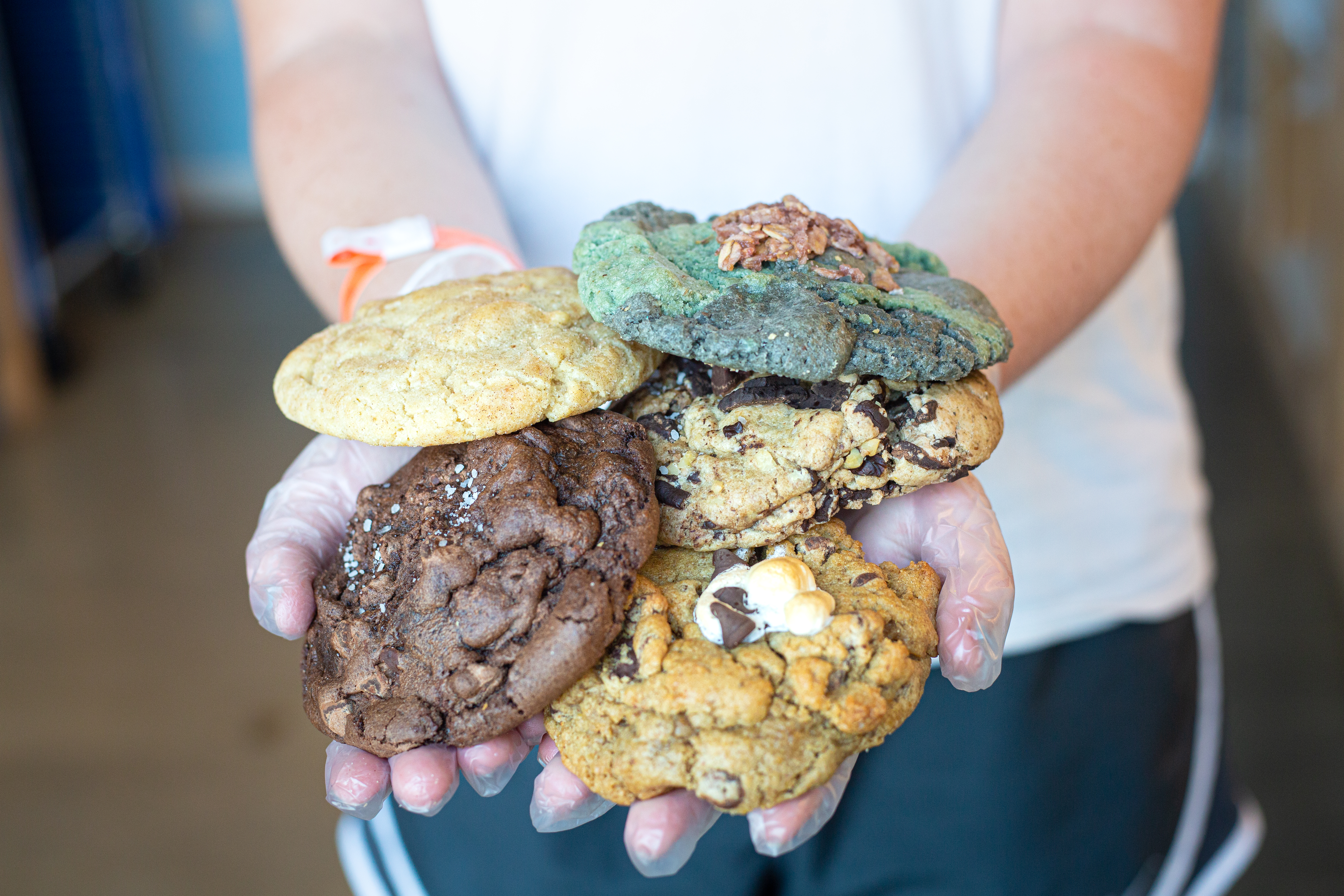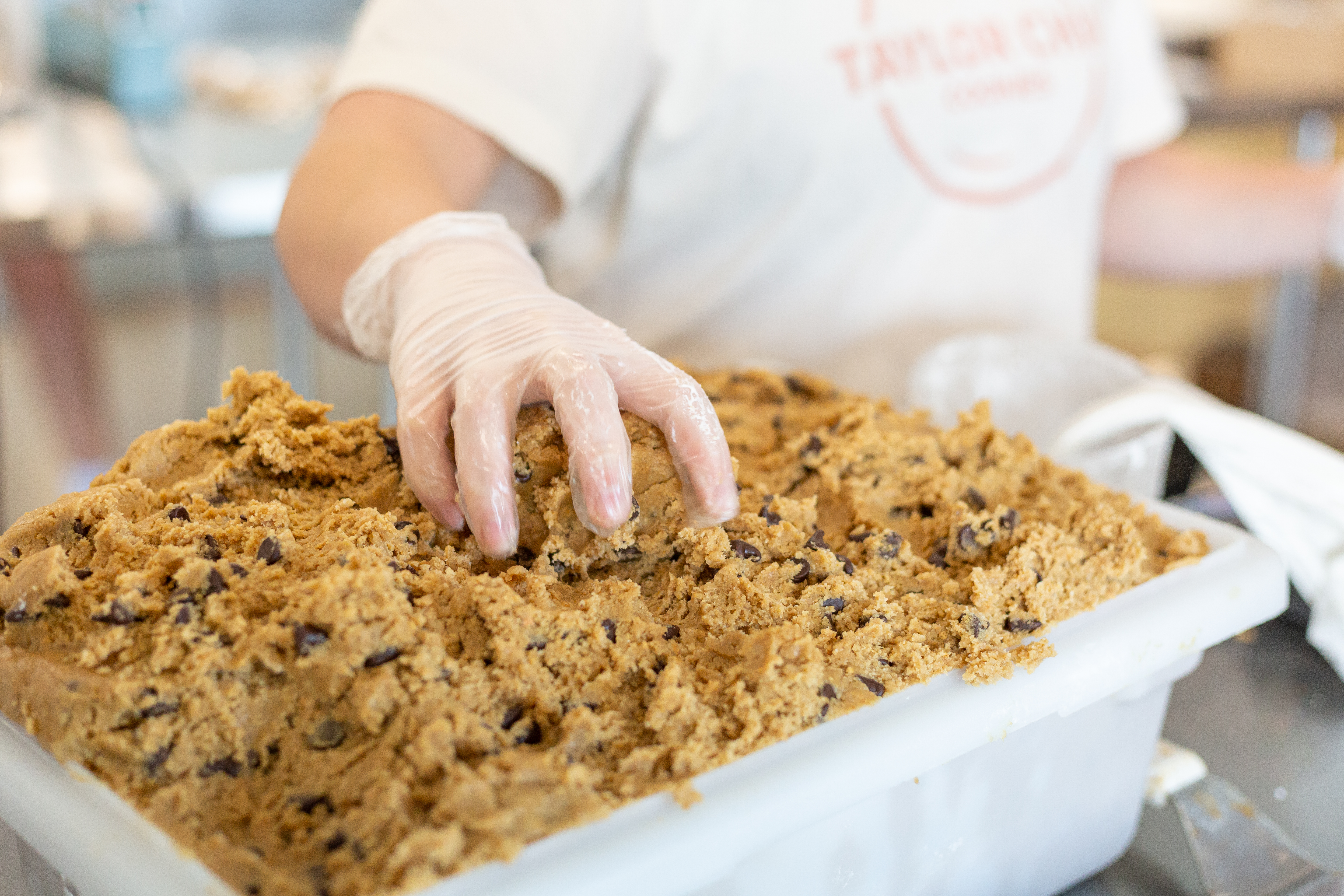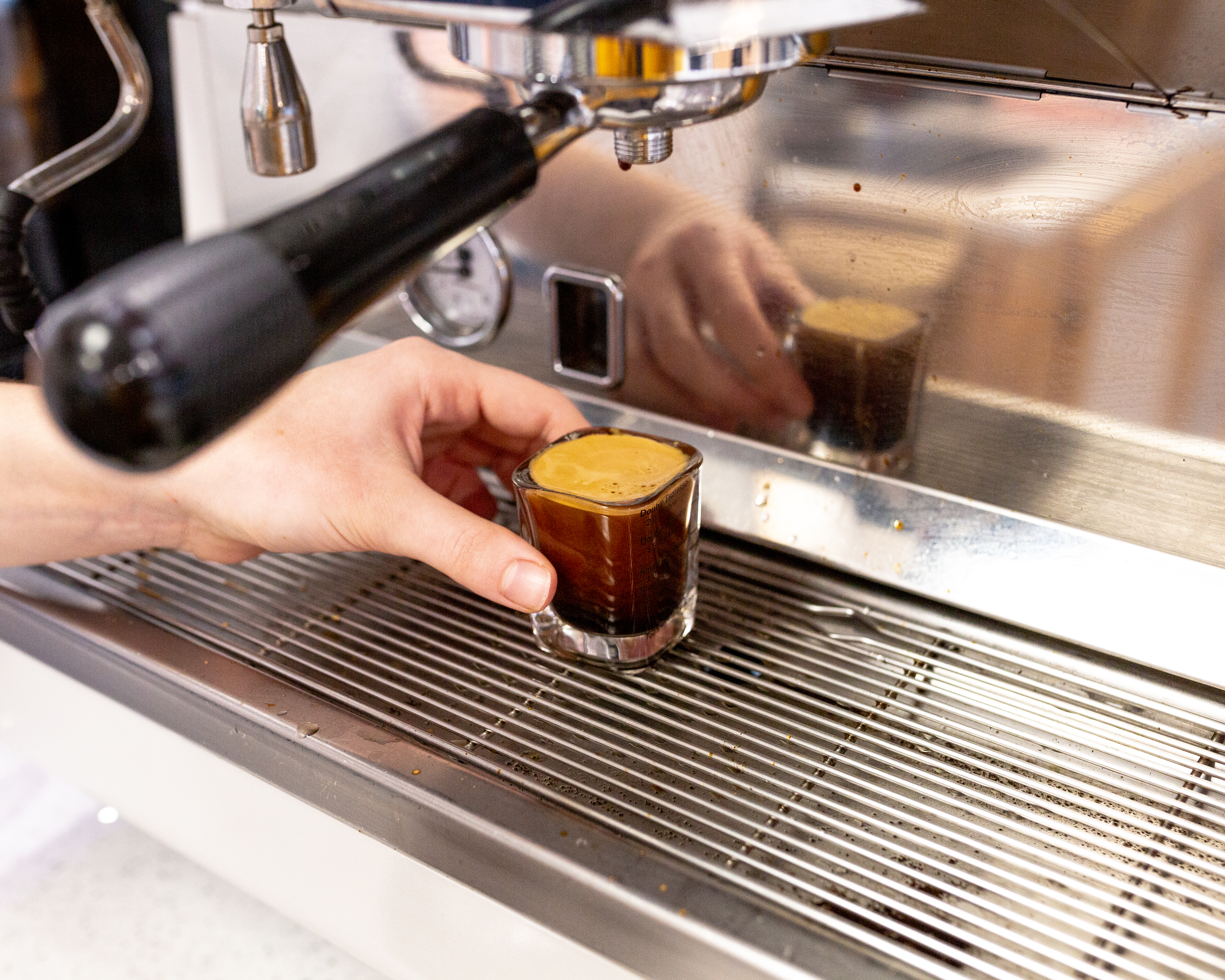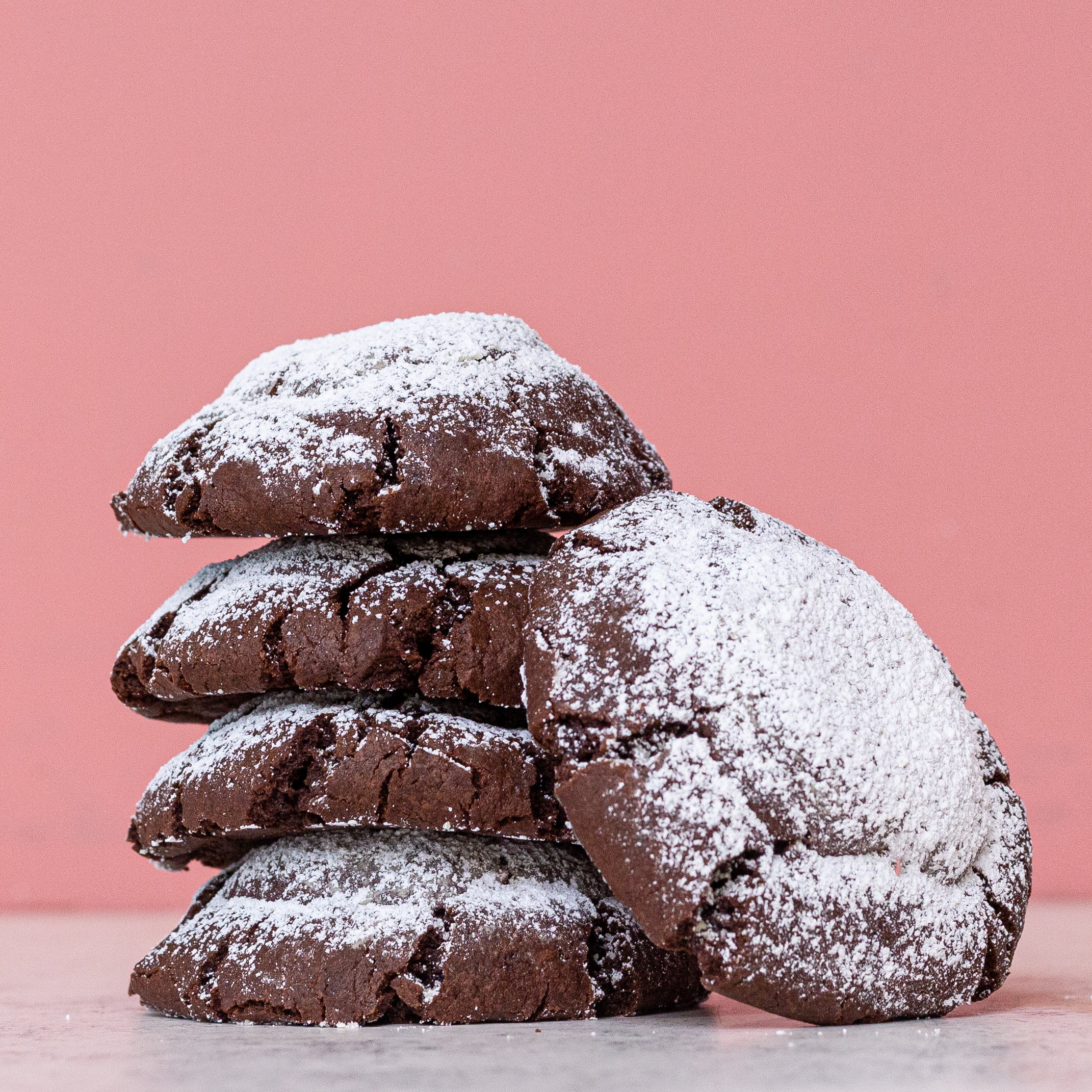Here's a straightforward guide to making your own classic biscotti. Start by whisking together all-purpose flour, a pinch of baking powder, and a dash of salt. In another bowl, mix eggs, granulated sugar, and a splash of vanilla until well combined. Combine the wet and dry ingredients, then gently fold in chopped almonds. Shape the dough into two logs, and after a quick chill, bake them until golden brown. Once cooled, slice into 1-cm thick pieces and bake again to achieve that signature crunch. Don't forget to add a hint of citrus zest or spice for an extra kick. Curious about more tips and variations? There's plenty to explore to perfect your biscotti game.
Key Takeaways
- Combine all-purpose flour, sugar, baking powder, and salt; sift together to prevent clumps.
- Blend in eggs, vanilla extract, and unsalted butter to form a cohesive dough.
- Shape the dough into two logs, chill, then bake until golden brown.
- Slice the baked logs into 1-cm thick pieces and bake again for a crispy texture.
- Mix in almonds for classic flavor, and store finished biscotti in an airtight container.
Introduction to Biscotti
Biscotti, you've likely seen or tasted these iconic Italian cookies, but have you ever wondered about their beginnings? They originate from Italy, steeped in a rich history that dates back centuries, often made with traditional ingredients like almonds or anise. Let's explore how these crisp, twice-baked treats evolved from simple nourishment to worldwide café favorites.
Origin and History
Delving into its origins, you'll find that biscotti dates back to Ancient Roman times, prized for its durability on long journeys. Originally, these Italian biscuits weren't the sweet treat you're familiar with today. Instead, they were more about practicality. The name "biscotti" itself, stemming from the Latin "biscoctus," meaning "twice-cooked," hints at their unique baking process. This method not only gave them their distinctive dry and crunchy texture but also meant that they could be stored for long periods – an essential feature for travelers and soldiers.
Fast forward to the Renaissance in Tuscany, and you'll discover the transformation of biscotti into the beloved Italian biscotti recipe you know now. It was here that the traditional almond biscotti recipe began to take shape, incorporating local almonds into its dough. The classic almond biscotti soon became a staple in Italian households, with each region adding its twist, leading to a variety of classic biscotti flavors.
Today, homemade biscotti continue to charm the world, merging traditional biscotti recipes with new, inventive flavors. Whether you're sticking to the classic Italian biscotti recipe or experimenting with different additions, the essence of these twice-baked Italian biscuits remains unchanged, offering a timeless slice of Italian culinary history.
Traditional Ingredients
When making traditional biscotti, you'll typically need a few key ingredients: flour, sugar, eggs, and almonds. This simple combination forms the backbone of your classic biscotti recipe. To guarantee you achieve that beloved crunchy texture, it's essential to mix the right proportions.
Here's a breakdown of the essential components:
- All-purpose flour - The foundation of your biscotti starts here. You'll use about 2 cups to provide the necessary bulk and texture.
- Granulated sugar - Adds sweetness and contributes to the golden color upon baking. Approximately 1 cup should suffice.
- Eggs - Acts as a binder for your dry ingredients. Three large eggs are typically beaten into an egg mixture.
- Almonds - Chopped or whole, they're crucial for that authentic crunch and flavor.
To enhance the flavor, don't forget a teaspoon of vanilla extract and a dash of almond extracts. For an aromatic twist, a bit of citrus zest works wonders. Combine these with a teaspoon of baking powder to help your biscotti rise just enough during baking.
Mix your dry ingredients with the egg mixture gradually to make sure everything combines well without overmixing. This careful process will guarantee your biscotti turns out perfectly crunchy and delicious every time.
Preparing the Dough
To start preparing your biscotti dough, you'll first need to mix all the dry ingredients together. Once that's done, you're ready to slowly incorporate the wet ingredients until the dough just comes together. Remember, the key is to mix until combined, but don't overdo it; keeping the dough light will help achieve that classic biscotti crunch.
Mixing Dry Ingredients
Begin by whisking together flour, baking powder, and salt in a large mixing bowl. This initial step is important as it guarantees that these dry ingredients are evenly distributed throughout your biscotti dough, preventing any lumpy surprises. You're aiming for a uniform flour mixture that will serve as the base for your delicious Italian cookies.
When handling the dry ingredients, keep these tips in mind:
- Measure Accurately: Use a spoon to scoop the purpose flour into your measuring cup, then level it off with a knife for precision.
- Sift to Avoid Clumps: If you notice any clumps in the flour or baking powder, don't hesitate to sift them. This adds a lightness to the dough.
- Keep a Separate Bowl Handy: Have a separate bowl ready to deal with any excess or to correct measuring mishaps.
- Prepare Your Workspace: Before you start, lightly dust your surface with flour. This will help in the later stages when you're shaping the dough.
As you mix, you might find the need to sprinkle additional flour to achieve the right consistency. Don't be shy to add a sprinkle of flour here or there, or even a layer of flour if your mixture feels too sticky.
Incorporating Wet Ingredients
Now add the eggs, sugar, and vanilla extract to the dry mixture, stirring until just combined. This is where your biscotti recipe really starts to take shape. You're working with simple ingredients, but the magic is in how they come together. Grab your electric mixer and gently incorporate these wet ingredients until you've got a cohesive biscotti dough. It might be sticky at first, but that's just part of the fun.
Next, toss in some unsalted butter. This isn't in all basic biscotti recipes, but it'll give your cookies a richer flavor and tender crumb. Mix it in until everything looks evenly distributed. You don't want any butter streaks in your final dough!
Once your dough is ready, lay out a piece of plastic wrap on your counter. Transfer the biscotti dough onto it, then use the wrap to shape the dough into a log. This will make it easier to handle and keep everything tidy.
Shaping and First Bake
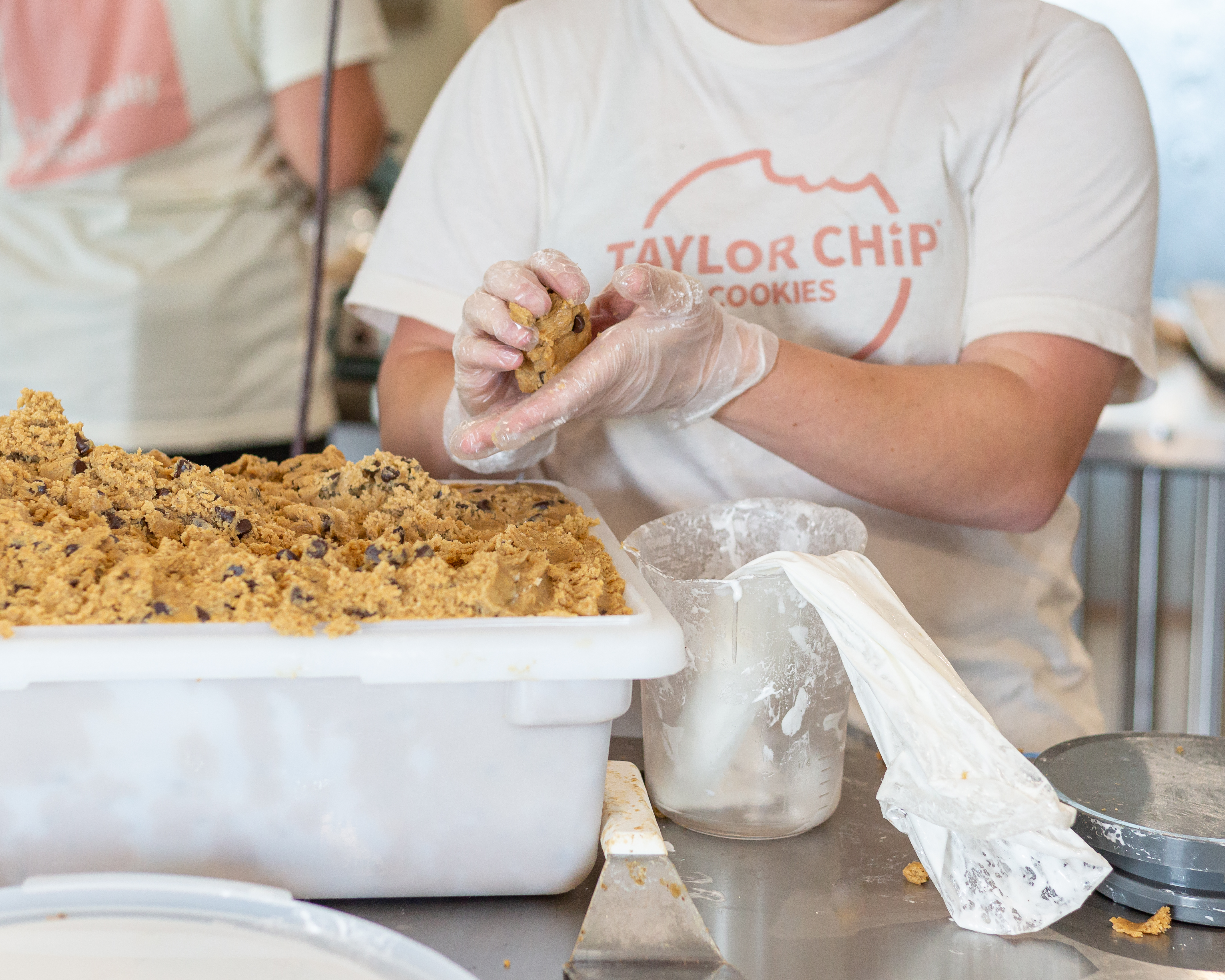
Now that you've got your dough ready, it's time to shape it into logs. You'll want to make sure they're even so they bake properly; just pat them down gently on a lined baking sheet. Then, pop them into the oven for the first bake, which sets them up for that classic biscotti crunch.
Forming the Logs
Once your dough is ready, shape it into two long logs on a lightly floured, clean surface. This step is pivotal as it sets the foundation for your classic biscotti shapes. If your dough feels too sticky, don't hesitate to sprinkle a bit of extra flour to make handling easier. Using your hands, gently form dough into two even-sized logs that are about half an inch high and several inches wide. Here's a quick guide to perfect your biscotti logs:
- Dust Your Hands and Surface: Before you start, make sure your hands and the surface are well-floured to prevent sticking.
- Divide the Dough: Use a bench scraper or a sharp knife to divide the cookie dough evenly into two portions.
- Roll and Shape: Gently roll each portion into a log shape on the floured surface. If the dough is resistant, let it rest a minute before continuing.
- Transfer Carefully: Lift each of the dough logs with both hands and place them onto a prepared baking tray, ensuring they have enough space to spread a little during the initial bake.
Initial Baking Process
Have you placed your shaped logs on the baking tray? Before you pop them into the oven, let's make sure everything is set for success. First, double-check that your tray is lined with parchment paper. This simple step helps prevent sticking and ensures your biscotti logs come off easily after baking.
Now, about that oven temperature—preheat it to 350°F. Consistent heat is key to getting those logs just right. Did you chill your logs in the refrigerator before baking? It's a good trick to help them keep their shape and enhance the texture of your biscotti.
Slide your tray with parchment paper into the oven and set your timer. You're looking at a baking time of about 20-25 minutes. Keep an eye on them! You want them to reach that lovely golden brown color without overdoing it.
Once done, remove the tray from the oven and let the logs cool slightly on it. Then, transfer them to a wire rack to cool completely. This stops the baking process and prevents the bottoms from becoming too hard.
Patience is key here; let them cool thoroughly before moving on to slicing. That's when the real transformation happens!
Slicing and Second Bake
Now that you've given your biscotti its first bake, you're ready to tackle the essential steps of slicing and baking it again. You'll need to cut the loaf at a slight angle; this isn't just for looks, but it helps in creating that classic biscotti crispness. Once they're neatly sliced, it's time to pop them back in the oven to dry out and achieve that delightful crunch we all love.
Cutting Techniques
After cooling slightly, you'll need to slice the biscotti log diagonally into pieces before baking them a second time to achieve their classic crispiness. The right cutting techniques are essential here to guarantee your biscotti not only look good but also have that perfect texture in the finished product. You'll want to use a serrated knife or a very sharp knife for clean cuts. Here's what you need to keep in mind:
- Serrated Knife: Ideal for sawing through the crust without crushing the log shape.
- 1-cm Thick Biscotti: Aim for uniform slices about 1-cm thick to ensure even baking later.
- Parchment-Lined Baking Sheets: Arrange the slices on parchment-lined baking sheets with biscotti flat, not overlapping.
- Biscotti Tops Facing Up: This exposes the cut sides, enhancing the drying out process during the second bake.
Guarantee that each slice is uniform to avoid pieces that bake too quickly or remain too chewy. Gently lay them on the cookie sheet and make sure the biscotti tops are facing up. This attention to detail in cutting will set you up for success in the next steps of baking!
Final Baking for Crispness
Once you've sliced the biscotti log, it's time to bake them again to perfect their crunch. Lay the slices flat on a baking sheet, ensuring they don't touch. This second phase in your biscotti baking is essential for achieving that traditional crispiness.
Now, set your oven timer for another 12-16 minutes. Keep a close eye on them; you're aiming for a golden hue, not a burnt disaster! After this initial phase, if you're yearning for a crunchier cookie, flip the slices and bake for an additional 15-20 minutes. This extended cooking method allows both sides to dry out thoroughly, transforming your homemade biscotti cookies into the ultimate dunkable delights.
Remember, the total baking time could range from 25-30 minutes if you prefer a lighter crunch, or 30-35 minutes for those who love a heartier snap. Each oven is different, so adjust the timing as needed.
This recipe for biscotti is a tribute to the beauty of patience and precision in baking. Once mastered, the process of crafting classic biscotti cookies becomes a rewarding ritual in your culinary repertoire. Enjoy the satisfying snap with your next cup of coffee!
Flavor Variations
Now, let's explore some exciting ways to jazz up your biscotti. Whether you're a fan of the classic almond, fancy a bit of chocolate chip, or prefer the tartness of cranberry with the crunch of pistachio, there's a variation just for you. You can easily customize your next batch to match your taste or the occasion you're baking for.
Classic Almond Biscotti
You can easily customize your classic almond biscotti recipe by incorporating various flavor additions and twists. Starting with the basic ingredients like plain flour, baking powder, egg yolks, and white sugar, you've got a solid foundation. Add a teaspoon of vanilla and a tsp of almond extract to deepen the flavors. Whether you're a fan of almond slivers or prefer the crunch of raw almonds, these recipes for almond biscotti are versatile and can be tailored to suit your taste.
Here are a few ways to enhance your classic recipe:
- Citrus Zest: Add the zest of an orange or lemon for a fresh, zesty kick.
- Spices: Incorporate a pinch of cinnamon or nutmeg to add warmth and spice.
- Dried Fruit: Mix in chopped dried apricots or cranberries for a sweet, chewy texture.
- Nuts: Besides almonds, consider tossing in chopped pecans or walnuts for extra crunch.
Each tweak adds a unique twist, making your biscotti not just a treat, but a personal statement of your culinary style. Experiment and find the combinations that speak to you the most!
Chocolate Chip Biscotti
Let's explore how adding chocolate chips can transform your biscotti into an indulgent treat. When you mix in dark chocolate chips, the rich flavor deepens, making each bite a delightful contrast to the crunchy biscotti base. You can also try mini chocolate chips for a more even distribution of chocolate goodness in every nibble.
For your chocolate biscotti, consider blending different types of chocolate. Combine dark chocolate, white chocolate, and bittersweet chocolate chips to create a complex flavor profile that tantalizes the taste buds. This mix not only enhances the texture but also adds visual appeal with varied colors peeking out from the biscotti.
Cranberry Pistachio Biscotti
Adding cranberries and pistachios to your biscotti introduces a delightful mix of tartness and crunch that elevates this classic treat. This variation, often called cranberry orange biscotti, incorporates tangy cranberries and rich, unsalted pistachios into the basic recipe, transforming these Italian cookies into a festive and colorful delight.
When you dip these biscotti in hot coffee or a glass of vin santo, a sweet dessert wine, they become the perfect accompaniment to your relaxation moments. Imagine the burst of cranberry tartness followed by the subtle, nutty flavor of pistachios—all enhanced by your warm drink.
Here's how to make sure your cranberry pistachio biscotti turn out just right:
- Use Fresh Ingredients: Fresh cranberries and high-quality unsalted pistachios make a big difference.
- Proper Storage: Keep them in an airtight container to maintain freshness.
- Follow Measurements: Stick to the recipe's recommended tablespoon of baking powder for perfect lift.
- Cooking Time: Watch your baking time closely to avoid overly hard cookies.
Serving and Storing
Once you've baked your classic biscotti, you'll want to know the best way to enjoy and keep them fresh. Pairing them with the right beverage can enhance their flavors, whether it's a robust espresso or a sweet dessert wine. To maintain they stay crisp and delightful, learning proper storage methods is key.
Pairing with Beverages
Pairing your classic biscotti with the right beverage can elevate both the flavor experience and enjoyment. Whether you've infused your biscotti cookies with orange zest, lemon zest, anise extract, or used olive oil for a lighter texture, there's a perfect drink out there to complement your creation.
- Cup of Coffee: A steaming cup of coffee is the traditional go-to for biscotti. The robust flavor of coffee balances the sweetness and enhances the subtle spices in biscotti recipe flavors.
- Hot Chocolate: For a cozy, comforting pairing, dunk your biscotti into hot chocolate. This combination works wonderfully, especially if you've added a touch of citrus zest to your biscotti.
- Dessert Wine: A sweet dessert wine, like Vin Santo, pairs beautifully with almond or hazelnut biscotti. The wine's sweetness complements the biscotti's crunch and nuttiness.
- Tea: A delicate black or herbal tea can also be a great match, especially if your biscotti cookie includes lighter flavors like lemon or anise.
Proper Storage Methods
To maintain your biscotti's freshness and texture, storing them correctly after baking is important. Once you've followed the recipe, baking them initially for 15-20 minutes, then slicing and baking for 12-16 more minutes, let them cool on the baking sheet for 10-15 minutes. After that, transfer your biscotti to a cooling rack for another 3-5 minutes to make sure they're thoroughly dry.
For the best results, use 2 cups all-purpose flour in your recipe. This type of flour helps to create the perfect crispy texture that biscotti are known for. Once completely cool, the proper storage methods become your next focus to prolong the life of biscotti. Store them in an airtight container at room temperature. They'll stay fresh for up to two weeks, maintaining their delightful crunch.
Avoid storing them in the refrigerator, as the moisture can soften them. If you need to keep them longer, freezing is a great option. Place the biscotti in a single layer on a baking sheet to freeze them individually, then transfer to a freezer-safe bag or container. They can last up to three months frozen, ready to be enjoyed after a quick thaw at room temperature.
Troubleshooting
Sometimes, even with a great recipe, you might run into a few hiccups while making biscotti. Don't worry, it's not just you; common issues can pop up, and luckily, there are straightforward solutions. Let's explore some tips for achieving that perfect texture and avoiding the usual pitfalls, ensuring your biscotti turns out wonderfully crisp every time.
Common Issues and Solutions
If your biscotti are too crumbly or dry, you might need to adjust the moisture content in your dough. It's essential to get the balance right between the dry and wet ingredients to avoid a tough or overly brittle texture. Remember, the key to perfect biscotti lies in the precision of your measurements and the consistency of your dough.
Here are a few adjustments you can make:
- Check your baking powder - Make sure you're using the correct amount, typically around a couple of teaspoons, to help your biscotti rise just right.
- Measure accurately - Use a baking scale for the dry ingredients to ensure the quantity of sugar and flour is exact.
- Oven temperature - Bake at the correct temperature, usually between 325°F to 350°F, for about 8-10 minutes per side until golden.
- Flavorings - Add a teaspoon of tsp vanilla or your preferred flavor to enrich the taste.
Tips for Perfect Texture
Achieving the perfect texture in your biscotti involves closely monitoring the baking process and making adjustments as needed. If you're aiming for a crunch that's satisfying without being too hard, consider the type of sugar you use. A recipe with caster sugar yields a finer crumb due to its small grain size. For a bit more crunch, try swapping in some brown sugar; it adds moisture and a lovely depth of flavor due to its molasses content.
Don't forget the role of extracts and zest. Adding a few teaspoons of anise extract can enhance the biscotti's aromatic profile, complementing the traditional almond notes. Similarly, a hint of lime zest can introduce a subtle, invigorating tang that cuts through the sweetness.
When rolling your dough into logs, sprinkle them with turbinado sugar. This coarse sugar not only adds a sparkly, crispy finish but also helps in achieving that golden-brown color you love. And if you're after a more delicate surface, dusting with powdered sugar before the final bake adds a light sweetness and a beautiful snowy look.
Health and Dietary Considerations
When you're whipping up a batch of classic biscotti, you might wonder about its nutritional impact. If you're avoiding gluten or adhering to a vegan diet, don't worry, there are adaptations just for you. Let's look at how you can tweak this traditional recipe to fit your dietary needs without sacrificing flavor.
Nutritional Information
Understanding the nutritional content of classic biscotti is essential, especially if you're monitoring your calorie intake or dietary restrictions. Typically, a single biscotti contains about 80-120 calories, depending mainly on the additions and size. The basic ingredients like flour, sugar, and eggs contribute to its carbohydrate and protein content, but it's the extras that really define their nutritional profile.
For a healthier twist, consider these personalized adjustments:
- Reduce Sugar: You can cut the sugar amount by up to half or use alternatives like coconut sugar, which has a lower glycemic index.
- Add Fiber: Incorporate whole wheat flour or almond meal to increase fiber content, which can help in maintaining a fuller feeling longer.
- Boost Flavor Naturally: Enhance with natural flavors such as ½ teaspoon of baking powder mixed with fresh orange zest oils, aligning with your personal preference.
- Mindful Mix-ins: Choose nutrient-dense additions like nuts or dried fruit over chocolate chips or candied ingredients.
Understanding these options allows you to align the biscotti with your dietary goals while enjoying a treat that suits your taste. Always check the disclosure policy if you're using a recipe with an affiliate link, ensuring it fits your purpose and dietary needs.
Gluten-Free and Vegan Adaptations
If you're seeking biscotti that fit a gluten-free or vegan lifestyle, several adaptations can be made to the classic recipe to meet these dietary needs. First off, you'll need to swap out traditional wheat flour for a gluten-free alternative. Options like almond flour or a gluten-free all-purpose mix work wonderfully, giving your biscotti that desired crispness without the gluten.
Next, let's address the eggs, a common ingredient in traditional biscotti. For a vegan version, you can use flaxseed meal or chia seeds mixed with water as an egg replacer. This not only binds the ingredients but also adds a slight nuttiness that enhances the biscotti's flavor.
Don't forget about the butter. Coconut oil or a vegan butter substitute can be used in equal amounts to achieve that rich, buttery texture. And if your recipe calls for honey, simply swap it with maple syrup or agave nectar to keep things plant-based.
Lastly, check your add-ins like chocolate chips or nuts to verify they're also compliant with your dietary needs. With these simple swaps, you'll have delicious, guilt-free biscotti that everyone can enjoy, regardless of dietary restrictions.
The Taylors and Taylor Chip
Sara and Dougie, both sweet enthusiasts, started their baking journey together in 2015, quickly evolving from casual date nights to mastering the perfect cookie. As their relationship flourished, so did their passion for baking. They spent countless hours experimenting with flavors and techniques, transforming their kitchen into a trial lab for cookie perfection.
As you venture into your own baking adventures, consider the path that led Sara and Dougie to create the renowned Taylor Chip. Here's what you can learn from their journey:
- Experimentation is key: Always try new ingredients and combinations.
- Patience pays off: Perfecting a recipe can take time, just as it did for them.
- Shared passions strengthen bonds: Baking together can bring you closer to your loved ones.
- Celebrate small victories: Every successful batch is a step towards mastery.
Their dedication to the craft culminated in a cookie that wasn't just a treat; it was a symbol of their love and teamwork. So next time you're in the kitchen, remember the Taylors' story and let it inspire your culinary creations. Whether it's biscotti or cookies, the perfect recipe might just be one batch away.
The Taylor Chip Lava Cake Cookie
Now let's explore the Taylor Chip Lava Cake Cookie, a decadent twist that combines the richness of lava cake with the beloved texture of cookies. Imagine biting into a soft, double chocolate brownie cookie that surprises you with a gooey, homemade hot fudge filling. It's crowned with a light dusting of powdered sugar, making it not only a treat for the taste buds but also a feast for the eyes.
You've got options with this treat: warm it up for an oozing chocolate lava experience that perfectly mimics the molten center of a traditional lava cake, or enjoy it at room temperature for a satisfying fudge-like consistency. Either way, you're in for a chocolatey delight.
Crafted with premium ingredients like unbleached enriched wheat flour, local butter, and free-range eggs, each cookie is a tribute to quality and freshness. The addition of Dutch processed cocoa, natural vanilla flavors, and a hint of coffee enriches the deep chocolate taste.
They're baked and shipped the same day from Lancaster, Pennsylvania, ensuring you receive them as fresh as possible. Remember, they're shipped express to minimize transit time.
Frequently Asked Questions
Can Biscotti Dough Be Made Ahead and Refrigerated?
Yes, you can definitely make your dough ahead of time and pop it in the fridge. It's actually a great time-saver! Just wrap it up tightly in plastic wrap to keep it fresh. When you're ready to bake, let it sit out for a bit to soften slightly, which makes it easier to handle. This way, you're all set to go when you need those delightful treats ready for baking!
Are Biscotti Suitable for Vegan Diets?
Biscotti aren't inherently vegan, as they typically contain eggs. However, you can make them vegan by substituting eggs with ingredients like flaxseed meal or applesauce. Also, make sure that other components, like chocolate or flavorings, are vegan-friendly. It's a simple switch and doesn't compromise the crunch or flavor. Haven't tried it yet? Give it a go; you might just find your new favorite snack that aligns with your dietary preferences!
How Do I Prevent Biscotti From Crumbling When Slicing?
To prevent your slices from crumbling, you'll want to let the loaf cool slightly before cutting. Use a serrated knife and apply gentle, sawing motions; don't press down too hard. If you're still having trouble, try baking the loaf for a slightly shorter time before the first cut. This keeps it just tender enough to slice more cleanly. Finally, always make sure your knife is sharp for the best results.
What Is the Origin of Biscotti?
Biscotti originated in Italy during the Middle Ages, specifically in the region of Tuscany. You'd be surprised to learn that they were first made not for enjoyment over coffee, as you might today, but for long journeys and wars due to their long shelf life. Originally called "biscotto," meaning "twice-cooked," they were baked twice to dry them out completely, making them perfect for storage and transport.
Can Biscotti Be Made Gluten-Free Without Texture Issues?
Yes, you can absolutely make biscotti gluten-free without compromising on texture! You'll just need to swap out the wheat flour for a good-quality gluten-free flour blend. Look for one that's designed to mimic the properties of traditional flour. Adding a bit of xanthan gum can also help maintain the crunchiness and structural integrity you love in biscotti. So, don't worry, you won't have to miss out on your favorite treat!
Conclusion
So, you've mastered the classic biscotti! Whether you stick to the basics or venture into flavor variations, remember, practice makes perfect. If they're a bit too crunchy, adjust your slicing technique or baking time. Embrace any mishaps—they're just stepping stones to becoming a biscotti pro. And hey, why not try the Taylor Chip Lava Cake Cookie next for a gooey twist? Enjoy your baking journey, and share these delightful treats with friends and family. Happy baking!





